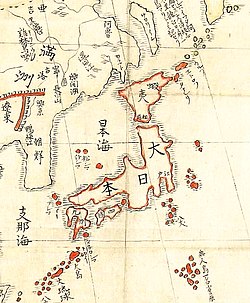Kaō (era)
Appearance
| Part of a series on the |
| History of Japan |
|---|
 |
Kaō (嘉応) was a Japanese era name (年号,, nengō,, lit. "year name") after Nin'an and before Jōan. This period spanned the years from April 1169 through April 1171.[1] The reigning emperor was Takakura-tennō (高倉天皇).[2]
Change of era
- January 30, 1169 Kaō gannen (嘉応元年): The new era name was created to mark an event or series of events. The previous era ended and a new one commenced in Nin'an 4, on the 8th day of the 4th month of 1169.[3]
Events of the Kaō era
- 1169 (Kaō 1, 3rd month): The former-Emperor Go-Shirakawa made a pilgrimage to Mont Koya.[4]
- 1169 (Kaō 1, 6th month): Go-Shirakawa accepted tonsure as a Buddhist priest; and he took the title Hōō.[4]
- 1169 (Kaō 1, 12th month): The chūnagon Fujiwara no Nurisika was banished to Bingo province as a consequence of complaints of Buddhist priests from Mt. Hiei; but shortly thereafter, he was recalled to Heian-kyō because of past services to Emperor Go-Shirakawa.[4]
References
- ^ Nussbaum, Louis-Frédéric. (2005). "Kaō" in Japan Encyclopedia, p. 480, p. 480, at Google Books; n.b., Louis-Frédéric is pseudonym of Louis-Frédéric Nussbaum, see Deutsche Nationalbibliothek Authority File.
- ^ Titsingh, Isaac. (1834). Annales des empereurs du japon, pp. 195-196; Brown, Delmer et al. (1979). Gukanshō, pp. 330-333; Varley, H. Paul. (1980). Jinnō Shōtōki. pp. 212-214.
- ^ Brown, p. 332.
- ^ a b c Titsingh, p. 196.
References
- Brown, Delmer M. and Ichirō Ishida, eds. (1979). Gukanshō: The Future and the Past. Berkeley: University of California Press. 10-ISBN 0-520-03460-0; 13-ISBN 978-0-520-03460-0; OCLC 251325323
- Nussbaum, Louis-Frédéric and Käthe Roth. (2005). Japan encyclopedia. Cambridge: Harvard University Press. 10-ISBN 0-674-01753-6; 13-ISBN 978-0-674-01753-5; OCLC 58053128
- Titsingh, Isaac. (1834). Nihon Odai Ichiran; ou, Annales des empereurs du Japon. Paris: Royal Asiatic Society, Oriental Translation Fund of Great Britain and Ireland. OCLC 5850691
- Varley, H. Paul. (1980). A Chronicle of Gods and Sovereigns: Jinnō Shōtōki of Kitabatake Chikafusa. New York: Columbia University Press. 10-ISBN 0231049404/13-ISBN 9780231049405; OCLC 6042764
External links
- National Diet Library, "The Japanese Calendar" -- historical overview plus illustrative images from library's collection
| Kaō | 1st | 2nd | 3rd |
| Gregorian | 1169 | 1170 | 1171 |
|
Preceded by: |
Succeeded by: |
